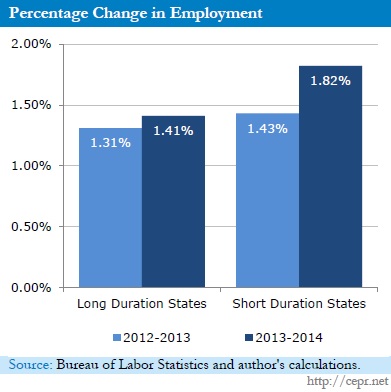January 26, 2015
A new NBER working paper by Marcus Hagedorn, Iourii Manovskii, and Kurt Mitman (HMM) argues that end of extended unemployment benefits at the start of 2014 explains much of the pick up in employment growth in 2014 compared with 2013. The story would be that the end of benefits gave people an incentive to find work. Their method is to compare the change in employment in states that previously had lengthy periods of benefit duration with states where benefit duration was already short prior to January of 2014.
The argument is that in the states that previously had long benefit duration we should expect the cut in duration to have a large effect. By contrast, in the states where benefit duration was relatively short, we would expect to see little effect. This means that we should see a bigger uptick in job growth in 2014 relative to 2013 in the states that previously had long periods of benefit duration than in states that had short periods.
They test this claim by first looking at state level data. They find that states with long benefit duration in fact had a bigger gain in the rate of job growth in 2014. They then look at adjacent counties in the states with long benefit duration and states with short benefit duration. They find that the counties in states that had previously had long benefit duration saw a larger uptick in job growth.
This is an interesting result which contradicts much prior research indicating that shortening benefit duration had little impact on employment growth (e.g. here, here, here, and here). It is worth testing this result with an alternative data series. HMM use the Current Population Survey for the state level data and the Local Area Unemployment Statistics (LAUS) for the county level data. These series are both problematic for this sort of analysis.
First, state level data for the current population survey is extremely noisy. Results can easily be driven by errors in the data.
The second issue is that these are in principle household based surveys that report employment based on where someone lives. This is problematic because unemployment insurance will depend on the state in which a person works. If a person lives in New Jersey but works in New York, then they will get benefits according to New York law, not New Jersey law. If New Jersey increases or reduces the duration of benefits, it will not have a direct effect on this person’s work behavior.
The third problem is that the LAUS data are largely model driven. There is little direct data for many counties. The Bureau of Labor Statistics (BLS) generates employment estimates for these counties from a variety of variables, including unemployment insurance claims. This makes them of questionable value in this sort of exercise.
The BLS Current Employment Statistics (CES) survey provides a useful alternative measure. The same sort of test can readily be constructed at the state level using the CES data. The CES has the advantage of both being a much larger survey (it surveys 144,000 establishments every month) and it is a survey of employers. The larger size means that there is considerably less noise in the monthly data. The fact that it is an employer survey means that we are measuring the number of jobs in the same states as we are measuring changes in benefit duration.
Following HMM, I divided the states into a long duration group, that previously had a benefit duration period of greater than 54 weeks, and short duration group for states that duration periods of 54 weeks or less. While HMM found the long duration group had a sharper uptick in job growth, the CES data show the opposite.

An unweighted average of the long duration states showed their rate of job growth increasing from 1.31 percent in 2013 to 1.41 percent in 2014. By comparison, job growth in the short duration states increased from 1.43 percent in 2013 to 1.82 percent in 2014. (The calculations run from November to November in both cases, since data are not yet available for December.)
This runs completely counter to the claim that shortening benefit duration provided a boost to employment growth. The states in which HMM expected the cuts in duration to have the greatest effect on growth actually saw less of an uptick than the states where they expected a small effect. This is consistent with prior research showing that the main impact of cuts in benefit duration is that more people leave the workforce, not that more people get jobs.






